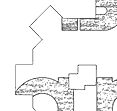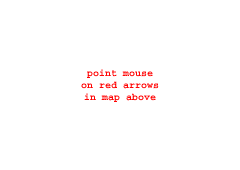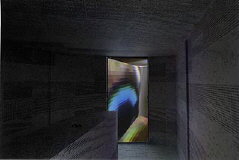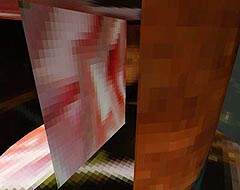The computer animation which was used to simulate the journey through the labyrinth of information in the video Rosa Binaria has now become a tangible experience in the installation Der Faden (The Thread). Here, the letters of the word rose are brought back into material reality, enlarged, and transformed into sculptures. They become real spaces that we can walk through. However, the letters are no more than a fraction of the text. We guess the rest of the text on the basis of the traces which it leaves behind on the walls of the installation space.
|
|
|
|
|
|
|
|
|
|
|
|
|
|||||||
 |
|
|
|
|||||
|
|
|
 |
|
|||||
|
|
|
|
||||||
|
|
|
|||||||
|
|
|
|
||||||
 |
|
|||||||
|
|
 |
|
||||||
 |
|
|
||||||
|
|
|
|||||||

Paper is spread across the walls of the four letters, printed with the complete ASCII text code which the computer requires for the description of depiction of a rose. A different picture of a rose is hidden in each of the letters. The pathway which the visitor takes through the labyrinth of the word rose runs in the direction in which one would read the word. The fourth letter, e, is in semi-darkness. A reprojection screen is located here, adopting the function of a door and forming the end of the pathway in the real world. A video beamer projects from outside computer-generated images onto this screen door, perceived by the visitor from the inside. The visitor may interact with these images via an interface and therefore continue the pathway within the text in a virtual state, moving freely, but only within the letters - the view from outside is not permitted.
 |
 |
The virtual journey is structured like a computer game: The depiction of the rose - which in reality is printed onto each letter in the exhibition room as ASCII Code - can be decoded and represented as rose images. Due to the fact that there are several real letters in the exhibition room carrying the secret images (ASCII Code), a number of the ASCII-coded images must also be decoded in the game. The goal of the game is to be able to view the apparently closed-off system from outside. In order to do this, one must find all hidden images. It is only then that chaotic processes are initiated in the system. For a moment the observer is given the posibility of entering into another dimension. However, this last action of the observer precipitates the subsequent destruction of this world of images, which can only be viewed from the outside. Alternatively, one can decide to leave the game at any time by opening the real screen door and exiting.
 |
 |
(Frankfurt 1992-96)
This installation was developed
on an Silicon Graphics workstation with the software Clovis (Medialab)
and Explore (Alias|Wavefront) in the INM (Institute for New Media). Presented
from "Kunstverein Celle" in the "Gotischen Halle" in Celle Palace. Concept:
Alba D'Urbano, Nicolas Reichelt and Michael Klein. Programming: Nicolas
Reichelt. Computer Animation: Alba D'Urbano and Nicolas Reichelt, Construction
of the Object: Pinus GmbH.
© 1996 Alba D'Urbano
// Alba D'Urbano
//

Main;
Archive() {
}
Esposizione Impraticabile();
Mare();
The Negated Room();
Hautnah;
Touch Me;
Stoffwechsel;
Il Sarto Immortale();
Net-Works();
History();
Imprint;